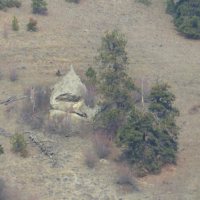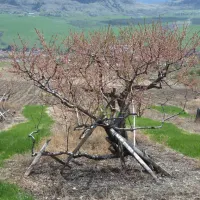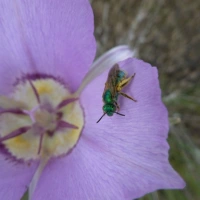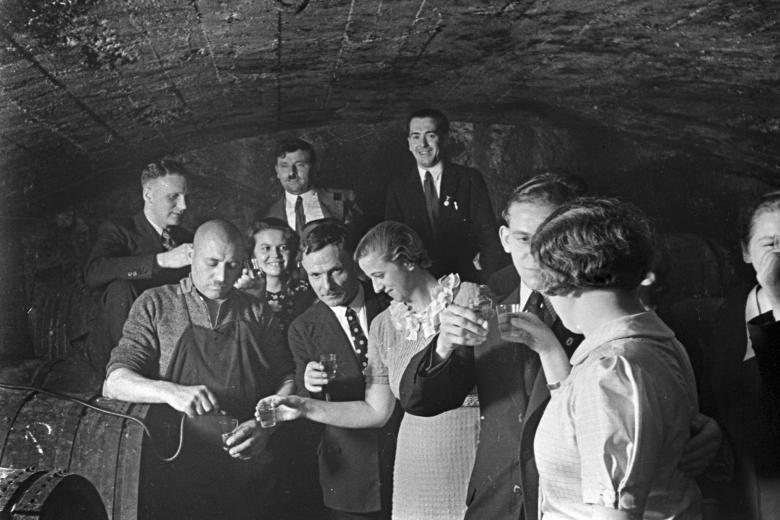Wine is largely made in laboratories. What is grown in the field is grapes.

The result is a decreased ability for the plant to distribute potassium where needed. The additional remove of huge amounts of potassium annually in fruit and dead canes is going to lead to suppressed bio-chemical activity in grapes and wine. In this case, starvation is likely an asset to the wine, here near the northern limit of red wine growing. The balance between starvation and survival is very tight, though. That’s not terroir.
Field practices control a balance of tartaric, citric and malic acids, and small quantities of aromatic compounds, but not the flavours of wine. Hot days and cool nights are important to get all that right, in a balance controlled by soil acidity, in response to rootstock and variety, and controlled by cluster exposure to the sun, crop load, general shading, weather and timing of harvest. In short, the goal is to manipulate these factors through horticulture methods to cause a vine to act as if it were in its optimal growing environment, which is, most certainly, not here.

Note the readily-propagating wild grapes on the slopes framing the cultivated vineyard. The levelling took place in the 1970s, with disastrous effects. Before that, the grapes were set on narrow terraces. Before that, they tumbled down the slopes. Note as well the blisters on the leaves to the left, a possible indication of the presence of the dreaded wine louse, that ended most self-rooted vines. Those seeking true wines, though, still take the risk. Intriguingly, these vines are not dying from it. Note the ground cover to control the chemical processes within the grapes. That’s a sign of what they want for an indigenous terroir, as is their mingling with the grass in the foreground.
An optimal environment would see grapes being able to successfully reproduce in place, either by layering or seed.

Note the wild vines rooting above the road cut, and the terraced slope to concentrate the sun in an otherwise wet environment. Note as well the interplay of stone, trees and vines. A plant that likes to climb other plants and grow more and more slowly, further and further from its source every year, is going to like that.
And to use the processes of fermentation for their own needs, as I detailed in this post back in 2012: https://okanaganokanogan.com/2012/02/12/marc/

Many factors are going to lead to that, but hot, tilled environments without copious rainfall or at least the ability to gather rot, leaves, seeds and water in appropriate places are not it.

The goal here was to bury all the topsoil with the clay subsoil. In effect, the soil is now dead, a victim of the assumption that soils are mineral compounds that can be made to give forth life by the addition of fertilizers. Never has there been a more clear example of settler culture!
After harvest, the wine is manipulated further, by type of pressing, with or without stems, with or without the addition of whole berries, the type of yeast added, timing and method of the stripping of excess acid, temperature of fermentation, leaving the grapes to lie on their yeast lees to draw out the off-flavours from bacterial fermentation to soften acids, and so on. It is a complex process that becomes an art through experience. It is also called terroir.
The Okanagan’s terroir screams tension. Pushing viticulture limits with extremes in temperature, latitude, soil diversity, and elevation. In fact, diurnal empteratures can fluctuate by 25 degrees in a single 24-hour period. Tension seems to be an unfamiliar experience to the conflict-avoiding Canadian personality; but in the base of the Okanagan, the tension is something Canadians can hang their hat on.
Despite what most people think, vines thrive in stressful conditions. The more fertile the land, the more fruit the vine will produce, but at a cost to quality. If the vine finds itself in a comfortable setting, it will produce more leaves than grapes. the vine is very happy providing shade upon its stocks basking in the sun. It loves to pump out enormous yields of fruit. Unfortunately, such harvests lack concentration in the grapes.
On the other hand, infertile soils in areas with extreme conditions like the Okanagan, forces the vines to work hard for each grape. This entails more dedication from the vine to each single grape, and cultivates dense, quality-driven traits which lead to top quality wine.
https://okanaganwine.club/bc-terroir/
A little too close for comfort to nationalist German ideals of Blood and Soil from the 1930s and early 1940s.
Not to mention the aristocratic notion that volume wine is not a quaffable drink, which is pure nonsense. Note the forcing, pain, violence and tension here and how once they are introduced to vines, so claims the writer, the vines are said to cultivate “dense, quality-driven traits.” Is that really far from Third Reich Notions that the “blood” of the German people could be “toughened” and made more independent and individual in the crucible of war? It was not meant as a metaphor. War was thought to actually change the spiritual composition of the blood, which would change an entire people’s genetics. Somehow this ghost of World War I has contaminated the Okanagan. Well, it’s unsurprising. The Okanagan was, after all, a Gau, a regional Nazi administrative district, during World War II, with a Gauleiter, a People’s Administrator, in waiting in Summerland. As for “shading the stocks” (stalks, I presume), what is wrong with such a feminine image? Well, nothing. As for “conflict-avoiding,” that’s one of the foundations of the Third Reich’s political, military and racial policy, the one that linked, in its view, the weaknesses of democracy with Jewishness and communism, all as dilutions of the strength of blood.
Let’s not go there! Let’s not even go close. It is dark place.
Want some fun? Play around on this page: https://de.wikipedia.org/wiki/Liste_bekannter_Darsteller_des_deutschsprachigen_Films. I’m pretty sure you’ll be able to identify most of the actors here. Note how the woman in the centre of the image is reaching out her full glass to have it filled even more. She can’t get enough!
That is how technological societies and societies based around manipulations of social privilege view things. It’s called manufacturing and selling. Terroir, however, would be to grow wine where it can reproduce and build those environments over time. Here, for example, are a couple pics I showed you the other day, to illustrate this point. First, a hang in the Mosel Valley. This time, note how the cliffs accumulate water, vines, leaves, weeds in little pockets, in a wet region where heat is intensified by vines. The mats of mould are going to create a complex, living soil, of which the vines, and their reproduction, are an expression.

Now, look at a similar environment in Vernon, close to the dead dump-trucked soil I showed you earlier in this post.

Yeah, it’s not an industrial landscape, but these bushes are thriving in the same way that the vines are in the Mosel, with the same concentration of mould, organic matter, water, soft soil, minerals, heat, water, birds and plant life. You could grow grapes here. This is their terroir. The stress would be on workers, not plants. Vineyard managers would have to get off their tractors, set aside their chemicals, climb the hills around the valley, and compete naturally with birds for the grapes, but the grapes would be indigenous and free. Anything else is human social terroir. It replaces Indigenous terroir. That pushing grapes to the limit thing is, troublingly, linked to unresolved issues of land title in the Okanagan. This post is meant to illustrate just how far we have to go.
Categories: Agriculture, Arts, Ethics, First Peoples, Industry, Land, Water, Wine















I’m not sure about this, but I think I’m doing some of the same thing you criticize when I/we try to grow varieties of grasses and forbs here (near Telkwa) in what was forest. Let’s make forest into prairie? Our soils are fungally-made, I think, and most of the writing (until just recently) was based upon a model of bacteriological creation.
(In my garden, I aim for fungus-soil and don’t try to get super-hot compost but rely more on sheet compost, or half-decayed stuff used as mulch or a cover-crop that winter-kills and is dense enough that I don’t have to till it.
If I am off track on this, don’t hesitate to suggest where, when, how, and why. 🙂
LikeLike
Have you tried mound gardening? I have a friend in Campbell River, who has had great results, piling up wood, covering it with dirt, and planting into the hills, which release nutrients as they decay. What’s more, it can be done in a wet area, without getting the crops wet.
LikeLike
Hugelkultur?
LikeLike
Yes.
LikeLike